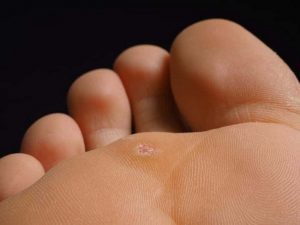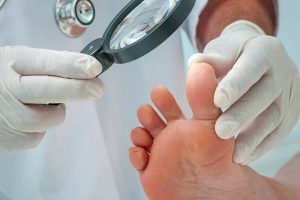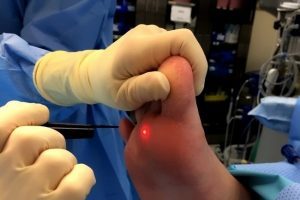Plantar wart is an extract of skin of a viral type, also called corn. From medical terminology, it is clear that such formations are localized to the soles of the feet and toes. In terms of oncology risk, they are not dangerous, but they create a lot of discomfort while walking due to their painful compression.
Causes of plantar wartsAll types of warts, including plantar warts, are caused by the human papillomavirus (HPV) virus. You can get it through close contact with infected people or through everyday life. The virus dies quickly from sunlight, but feels great in high humidity. Therefore, HPV infection often occurs in baths, saunas, swimming pools. The penetration of the virus into the body is facilitated by microtrauma and cracks in the skin, as well as reduced immunity.

With strong protective properties of the body, the virus after infection can remain in a dormant state indefinitely. But if the immunity decreases, it begins to actively multiply, stimulating the appearance of warts of different localization on the skin. As for what happens, the only thing that 1, 2, 4, 27 and 57 subtypes of HPV are often responsible for.
A number of predictable factors contribute to the appearance of these configurations:
- shoes
- that are too tight or out of size;
- wearing high heels often;
- various foot deformities (including flat feet);
- various diseases of the joints of the legs (arthritis, arthritis, etc. ).
Warts on the foot are more common in people with excessively dry skin and hyperkeratosis.
Thus, the causes of plantar warts are the same in all cases (HPV infection), but the predictable factors are different. The number and amount of skin elements depends on them and the state of immunity.
As seen plantar warts
Round skin growth is like a wart on the leg. It can be of various sizes, but rarely exceeds two centimeters in diameter. It rises above the level of the skin by no more than three millimeters, but at the same time goes deep inside with its root. The color may not be different from the surrounding skin, or it may be darker or lighter. Such formations often have a yellow or gray tint. Visually, when viewed inside the elements, black dots or lines can be seen (they are also clearly visible in the photo). This is the appearance of capillaries, in which blood clots have formed, due to the compression of the Horny masses by masses.
First, the plantar wart has a smooth surface. But over time, it becomes tough, rough, thickened. It is the horny masses that give these warts their yellow color.
Pain when compressed is an important symptom of plantar warts. Each stage causes the patient acute pain.
These warts are very similar to plantar calluses. The resemblance to a cornice is particularly noted because of the severe pain of both gels. The main difference is that the surface of the warts does not have a skin pattern, and the calluses remain.
Diagnosis of plantar warts
This disease will be diagnosed by a competent dermatologist on the basis of clinical pictures only. In some cases, an additional dermatoscope is required. The absence of a skin pattern on the formation and presence of capillaries with blood clots in its structure confirms this diagnosis.
Treatment of plantar warts

Plantar warts are more difficult to get rid of than similar formations in other areas due to their penetration deeper into the dermis. For small and newly formed elements, external necrotizing preparations can be used. Large and deep warts are surgically removed. At the same time, old formations should first be attenuated with keratolytic agents.
External preparations for removing warts
In some cases, such configurations can self-destruct. But since the plantar wart hurts so strongly, patients do not want to wait and try to get rid of them as soon as possible.
Any remedy for plantar warts that has a necrotizing effect is prescribed to remove small and superficial elements.
These products contain acids that attach to skin proteins, and cause necrosis. Refrigerant-containing drugs have a similar effect. But they create necrotizing effects by freezing tissues, not by chemical damage.
All of these drugs are applied punctually to the formulation. It is necessary to closely monitor that the substance does not enter the surrounding tissues, as this will cause burns. After treatment, a wound will remain on the site of the former wart, which will be covered with a crust. After healing, it will fall apart on its own. You can do such treatment at home, but as directed by a doctor.
In this way it is possible to remove a plantar wart of small size and with shallow penetration into the skin. For large elements, you need to use other methods to remove it, as recurrence of the wart tissue will certainly lead to recurrence.
Surgical methods for plantar warts
removal
There are various ways to remove a plantar wart in surgery. Best sweet modes:
- laser removal
- ; Radio wave knife
- ; cryodestruction
- ; electrocautery
- .
All of these procedures are performed on an outpatient basis. Patients can literally go home a few minutes after completion, simply treating the wound regularly at home.
The most effective and safest methods to remove plantar warts are excision with a laser or radio wave knife. When done, the vessels coagulate immediately, which is a good prevention of bleeding and secondary infection. Complications are extremely rare when removing skin formations by these methods. The same cannot be said about crystal-building and electro-heating, so these treatment methods are obsolete in the background and are rarely used.
If the warts are large or old (covered with many horny masses), it is recommended to treat them with keratolytic agents for two weeks before the removal procedure. For this purpose, salicylic ointment or acid and other drugs are prescribed. Thus, some of the horn scales can be exfoliated, to make the formations softer and more readable. This will make the wart easier and quicker to remove.
In rare cases, when there are many elements or there is doubt about their nature, the doctor may advise an exception to surgery with a scalpel. With this method of removing warts, the recovery period and the high risk of scarring are much longer, therefore it is used only under strict indicators.
Features of plantar warts in children
In children over the age of five, plantar warts are quite common, as they often run barefoot, are injured and do not always follow the rules of personal hygiene. Immune dysfunctions due to regular contact with sick children (in kindergartens and schools), leading to increased likelihood of warts.
Such formations in a child are best treated with external agents. You can try to exfoliate shallow elements using salicylic ointment, followed by pumice. Immunomodulating drugs are proving successful. When applied regularly to a wart, they can remove it in a few weeks.
If the elements are deep, apply necrotizing agents or remove a laser or radio wave knife.
Prevention of plantar warts
 It is completely impossible to protect yourself from warts, but you can reduce the risk of them occurring. To do this, you must act in two directions: get rid of predictable factors and stimulate the body's defenses.
It is completely impossible to protect yourself from warts, but you can reduce the risk of them occurring. To do this, you must act in two directions: get rid of predictable factors and stimulate the body's defenses.
To achieve the first goal, you need to:
- follow the rules of personal hygiene (do not walk barefoot in public places, wash your feet daily and make cuts and injuries in a timely manner); choose
- comfortable shoes by size;
- in time to prevent foot deformities and treat joint diseases.
A healthy lifestyle, playing sports, hardening, taking vitamin complexes and immunostimulating drugs as prescribed by a doctor will help keep the body's defenses at a good level.
For excessive dry skin and hyperkeratosis, regular medical and skin pedicure is recommended. For excessive sweating of the feet, you need to use special agents to treat hyperhidrosis. By following all these rules, the risk of developing warts on the soles of the feet is low.
Plantar warts are not a dangerous disease, but they cause a lot of discomfort due to pain while walking. Fortunately, modern medicine has many ways to get rid of it quickly and with little risk of a new relapse. To do this, you must consult a dermatologist and strictly follow all his appointments and recommendations.














































































